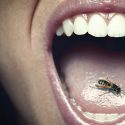You’re hiking in the woods. Suddenly, you feel something extremely itchy. You scratch it, and find a rash like a red bull’s eye on your body. Looking closely, you see a small hole. And it’s painful. If you don’t act quickly, your life could be in danger.
There are about 850 tick species in the United States. In 2018, the CDC reported almost 50, 000 cases of tick-borne diseases. Ticks are parasites that feed on your blood. They wait on tall pieces of grass, and when you pass by, they latch onto you and start feasting.
Most likely, you won’t feel the bite. And a tick’s body is small and relatively flat, so it’s easy for you to miss seeing it. Hours could pass before you notice that something has attached itself to you.
The problem is, before they bite you, ticks could have fed on an animal that’s infected with Lyme disease, or other diseases. And once it starts feeding on you, the tick’s saliva can transmit diseases to you. Why are tick bites so dangerous?
How can you check whether your yard is infested? If you’re bitten, why is it so important to keep the tick? Why is it important not to toss the tick away? watch till the end to find out.
STEP ONE: GET A LEG UP
If you’re going into an area that’s likely to be infested with ticks, it’s a good idea to wear light-colored clothing. Then it’ll be easier to see if there’s a tick on you, as they often look like a little bit of dirt. Also, wear long sleeves, pants, and tuck your pants into your socks or boots. On top of that, you can spray your clothing with an insect repellent containing DEET. And always wear work gloves if you’ll be working in your yard.
STEP TWO: CHECK YOURSELF
If you’re on a hike, or gardening, look for tick bites every two or three hours. It generally takes four hours for a tick to make you sick. Since tick bites are painless, and not filled with fluid like other insect bites, you’ll need to search for them. Ticks usually bite the back of the neck, the scalp, and any exposed parts of your arms and legs. These insects will stay latched onto you until they finish feeding, which can take from a few hours to days. And ticks can also make animals sick too, so make sure you check your outdoor pets regularly, especially if they’re scratching.
STEP THREE: DON’T LISTEN TO OLD WIVES’ TALES
If you do find a tick on you, don’t panic. and don’t put rubbing alcohol on it to suffocate it. The best way to remove a tick is to use a pair of tweezers. Grasp the tick where it’s attached to your skin, then pull the tick straight out. Make sure to pull slowly and firmly. And don’t jerk or twist the tick, as its mouthparts are like barbed wires digging into you. And if you squeeze its body, the little sucker may vomit its infected blood into your bloodstream. Who wants to be walking around with infected tick vomit in their body? Yuck. After you remove the bug, wash the area with soap and water.
STEP FOUR: KEEP THE TICK
once you get the tick off, save it in a plastic bag. If you start to get a rash that looks like a bull’s eye, you might have Lyme disease. But ticks can carry various diseases, including Rocky Mountain spotted fever and the Powassan virus. So saving the tick will help the doctors identify the bacteria or virus that the tick has transmitted to you. Tick bites can be serious, so watch out for a rash, chills, fever, joint pain, or any red streaks or yellow fluid oozing from the bite.
A tick bit Jennifer Sloane. When she went to the emergency room, she had a fever of over 40 °C (104 °F) and flu-like symptoms. Luckily, she told her doctors that she had removed a tick a few weeks earlier, which helped them treat her properly. She was suffering from meningitis, a liver problem, and sepsis, a dangerous infection in her bloodstream, and received three blood transfusions. She was in the hospital for 11 days.
STEP FIVE: CHECK FOR INFESTATIONS
You don’t need to nervous about going outside though. You can check for a tick infestation on your property by dragging a white, rough-textured cloth through areas where ticks might be. If the cloth collects lots of ticks, you have an infestation. A good rule of thumb is that the neater your yard appears, the less likely it is to be infested with ticks. And if you treat your property with a pesticide, focus on shrubs, tall grass, and overgrown areas you can’t reach with a lawnmower. You’ll probably want to get your pets treated as well.
Sources
- “How Ticks Work”. Tracy, V. Wilson. Howstuffworks.
- “6 Ways Ticks Can Make You Sick Or Kill You, From Lyme Disease To The Powassan Virus”. 2021. Insider.
- “Survivor of near-fatal tick bite has a lesson for summer”. Elizabeth Cohen, CNN Senior Medical Correspondent. 2021. CNN.
- “Lyme disease: A rigorous review of diagnostic criteria and treatment”. researchgate.net.
- “15 Important Facts You Must Know About Ticks”. Maria, Masters. 2021. health.com.
- “Prevention Is Key In Fight Against Lyme And Other Tickborne Diseases”. 2019. Centers For Disease Control And Prevention.
- “Tick Bites: First Aid”. 2021. Mayo Clinic.



























